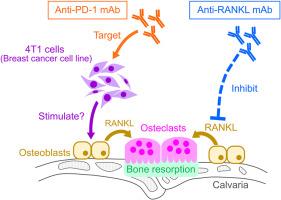Effects of anti-RANKL and anti-PD-1 antibodies on cancer-induced osteolysis in mice
IF 2.3
Q1 DENTISTRY, ORAL SURGERY & MEDICINE
引用次数: 0
Abstract
Objectives
Denosumab, an anti-bone resorptive agent composed of the anti-receptor activator of nuclear factor-κB ligand (RANKL) monoclonal antibody, and nivolumab, an immune checkpoint inhibitor composed of the anti-programmed death-1 (PD-1) antibody, are administered to suppress cancer growth. The present study examined the effects of the administration of anti-RANKL antibody alone and in combination with anti-PD-1 antibody on cancer-induced osteolysis in mice.
Methods
Cells from the mouse breast cancer cell line, 4T1, were injected into the subperiosteal region of mice calvariae, and anti-RANKL antibodies, with or without anti-PD-1 antibodies, were administered. From 0 to 15 days, tumor volume, osteolysis area, and osteoclast distribution were analyzed.
Results
Tumor volume and osteolysis area in the calvariae increased with time and the number of 4T1 cells injected. Administration of anti-RANKL antibody inhibited cancer-induced osteoclast formation and osteolysis but did not suppress tumor growth. Furthermore, the administration of anti-PD-1 antibody, with or without a low dose of anti-RANKL antibody, did not suppress tumor growth or osteolysis. However, an increase in osteoclast-like cells was found, not only in the calvariae, but also in cancer tissues that received anti-PD-1 antibody.
Conclusions
Inhibition of RANKL function by the anti-RANKL antibody did not affect tumor growth, although it suppressed osteolysis. Interestingly, the anti-PD-1 antibody induced osteoclast-like cells at the tumor sites. Thus, it is postulated that low-dose anti-RANKL and anti-PD-1 antibodies do not have synergistic effects on osteolysis, whereas anti-PD-1 antibody induces the formation of osteoclasts the treated tumor sites.

抗rankl和抗pd -1抗体对小鼠肿瘤性骨溶解的影响
目的利用核因子-κB配体抗受体激活剂(RANKL)单克隆抗体组成的抗骨吸收剂denosumab和由抗程序性死亡-1 (PD-1)抗体组成的免疫检查点抑制剂nivolumab抑制肿瘤生长。本研究检测了抗rankl抗体单独和联合抗pd -1抗体对小鼠癌症诱导的骨溶解的影响。方法将小鼠乳腺癌细胞系4T1细胞注射到小鼠颅骨骨膜下区,分别给予抗rankl抗体(含或不含抗pd -1抗体)。观察0 ~ 15 d肿瘤体积、骨溶解面积、破骨细胞分布。结果随着注射时间的延长和注射4T1细胞数量的增加,颅骨肿瘤体积和骨溶解面积增加。抗rankl抗体抑制癌症诱导的破骨细胞形成和骨溶解,但不抑制肿瘤生长。此外,抗pd -1抗体与低剂量的抗rankl抗体的结合或不结合,都没有抑制肿瘤生长或骨溶解。然而,不仅在颅骨,而且在接受抗pd -1抗体的癌症组织中也发现了破骨细胞样细胞的增加。结论抗RANKL抗体抑制RANKL功能不影响肿瘤生长,但可抑制骨溶解。有趣的是,抗pd -1抗体在肿瘤部位诱导破骨细胞样细胞。因此,我们推测低剂量抗rankl和抗pd -1抗体对骨溶解没有协同作用,而抗pd -1抗体诱导破骨细胞在治疗肿瘤部位形成。
本文章由计算机程序翻译,如有差异,请以英文原文为准。
求助全文
约1分钟内获得全文
求助全文
来源期刊

Journal of Oral Biosciences
DENTISTRY, ORAL SURGERY & MEDICINE-
CiteScore
4.40
自引率
12.50%
发文量
57
审稿时长
37 days
 求助内容:
求助内容: 应助结果提醒方式:
应助结果提醒方式:


